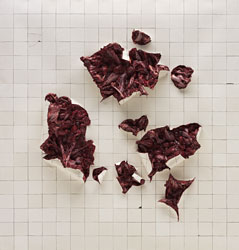Artist
Lucio Fontana Concetto spaziale, Attese (Spatial Concepts) 1965

Lucio FONTANA
Argentinian/Italian 1899–1968
Concetto spaziale, Attese (Spatial Concepts) 1965
water-based paint on canvas, white
130 x 97 cm
Solomon R. Guggenheim Foundation
Gift, Fondazione Lucio Fontana
© Courtesy of Fondazione Lucio Fontana
88.3590
Lucio Fontana worked as a painter and sculptor. He experimented with stone, metals, ceramics and neon. As a painter he attempted to go beyond the confines of the two dimensional surface. He aimed to achieve an expression of a fourth dimension. He wanted to fuse the categories of architecture, sculpture and painting to create a groundbreaking new artistic expression.
Materials and Techniques
From 1947 on, Fontana’s experiments were often entitled Concetti spaziali (Spatial Concepts). The artist’s sculptures brought colour, considered to be under the dominion of painting, into the realm of the three-dimensional. In his early painting series Buchi (Holes) he dared to puncture the surface of his canvases, breaking the membrane of two dimensionality in order to highlight the space behind and around the stretched canvas.
Starting in 1958, Fontana further reduced his paintings by creating matte, monochrome (one colour) surfaces, focusing the viewer’s attention on the slices that broke the taunt skin of the canvas as it was pulled over the stretcher. Paintings such as Concetto spaziale, Attese, 1965, have precise cuts that express the idea that the painting is a three-dimensional object, not solely a surface.

